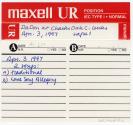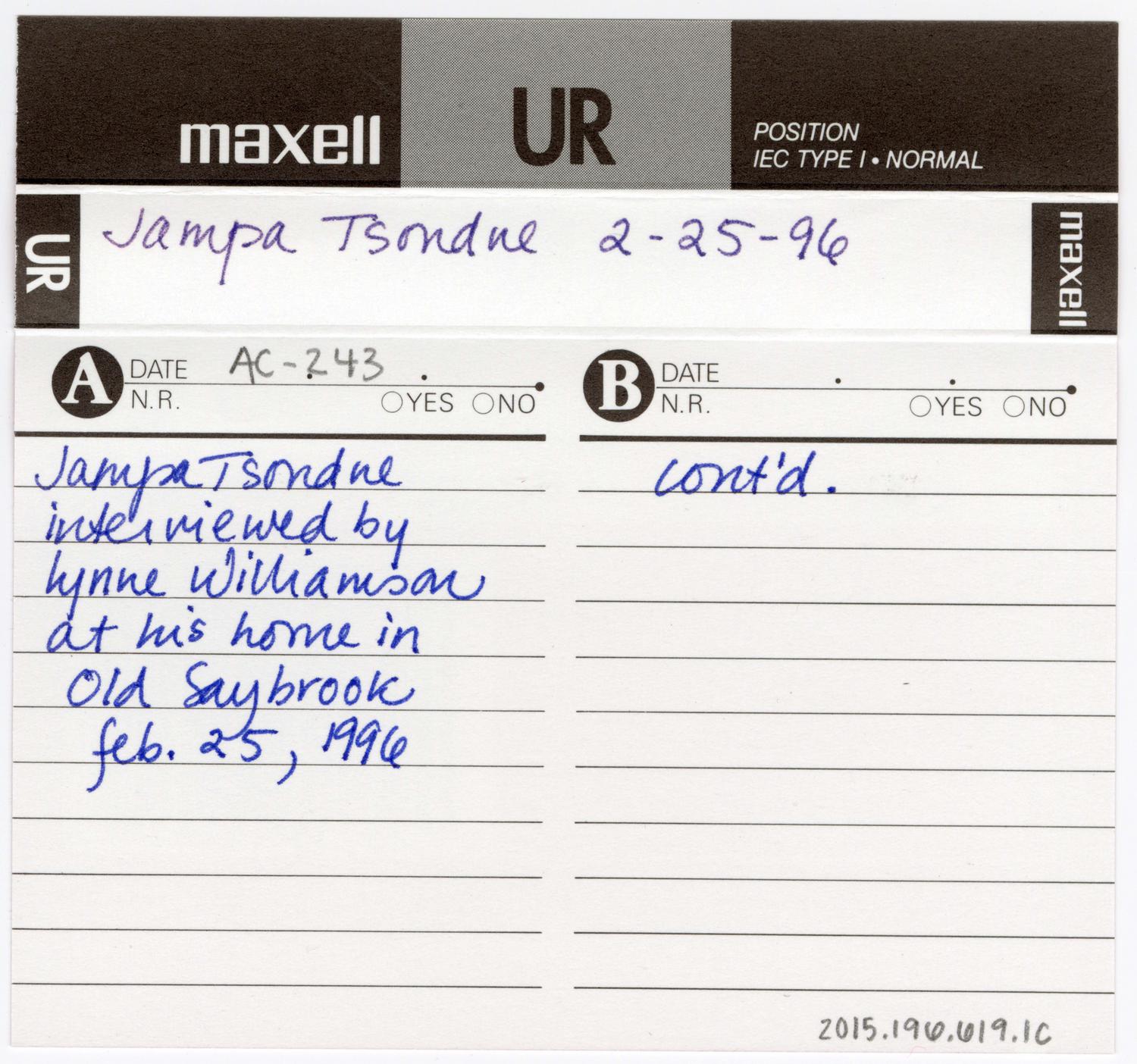Tibetan Concert at Charter Oak Cultural Center, Hartford
PerformerPerformed by
Dadon Dawa Dolma
(Tibetan, born 1968)
Date1997 April 3
Mediumreformatted digital files from audio cassette tape - MP3
DimensionsDuration (tape 1, side 1): 44 Minutes, 58 Seconds
Duration (tape 1, side 2): 35 Minutes, 16 Seconds
Duration (tape 2): 15 Minutes, 30 Seconds
Duration (total runtime): 1 Hours, 35 Minutes, 53 Seconds
ClassificationsInformation Artifacts
Credit LineConnecticut Cultural Heritage Arts Program collections
CopyrightIn Copyright
Object number2015.196.616.1-.2
DescriptionTwo audio cassette tapes of a recording of a Tibetan concert held at the Charter Oak Cultural Center in Hartford, Connecticut on April 3, 1997. Dadon plays two songs: Traditional and Lonf Sing Allegory. The event was recorded as part of the 1996-1997 exhibition project, "Auspicious Signs: Tibetan Arts in New England." This concert was part of the Connecticut Heritage Music Series 2, a collaboration between the Charter Oak Cultural Center and CCHAP from September 1996 through June 1997.
2015.196.616.1a-d: (tape 1) two digital files, tape information sheet, and cassette tape
2015.196.616.2a-c: (tape 2) one digital file, tape information sheet, and cassette tape
NotesSubject Note: The Connecticut Heritage Music Series, a collaboration between the Charter Oak Cultural Center and CCHAP from September 1996 through June 1997, presented the music of ten different Connecticut ethnic groups on ten "First Thursdays" to coincide with the "Connect the Dots" downtown Hartford entertainment initiative. Funding was provided by the Connecticut Humanities Council and the Connecticut Commission on the Arts. CCHAP and Charter Oak had partnered to present an earlier series presenting five folk musicians in 1994-1995, and they also presented a third series in 1997-1998, all held at Charter Oak Cultural Center.2015.196.616.1a-d: (tape 1) two digital files, tape information sheet, and cassette tape
2015.196.616.2a-c: (tape 2) one digital file, tape information sheet, and cassette tape
Biographical Note: Dadon Dawa Dolma has been a leading singer and composer of popular music in Tibet and later in the U.S. Sales of her six solo albums, sung in Tibetan, have reached millions in Tibet, China, India, Taiwan, Bhutan, and Japan as well as Europe since she began recording in 1989. Her music is modern and powerful, combining traditional and contemporary Tibetan melodies and instruments. The words of Dadon's songs are written by her and other Tibetans such as a monk working for the Dalai Lama in Dharmasala, India.
Like most Tibetans in exile, Dadon has been fervently committed to informing the world about Tibet's loss of freedom and culture under Chinese domination. Courageously using her popularity to express strong feelings about the liberation of Tibet became too dangerous, so in 1992, Dadon and her then-husband Phumba walked over the Himalayas to refuge in Nepal and later India. They immigrated to Connecticut in 1993, where their second son Tenzin Tashi was born, settling in Middletown.
Dadon learned traditional Tibetan songs from her mother, a renowned singer, later studying violin and piano at the Beijing University of Nationalities. She played in the Tibetan National Orchestra, then studied voice at the Chinese Musical College. Often in the West, Tibetan culture is thought to be homogeneous. In fact, Dadon's song style features elements from many kinds of Tibetan music and dance forms including secular traditional and modern, religious, and classical. Like musician Thupten Tenzin, she knows and loves all of these styles, believing that Tibetan culture will survive and strengthen through both preservation and innovation. Also an actress in theatre and films, Dadon has performed at community events and at several large benefits for Tibet, including at Carnegie Hall. She formed a performing group with musicians based at Wesleyan University in Middletown, Connecticut in the 1990s, performing widely with this group and solo around the East Coast and for several large Tibet benefit concerts in New York City including the Tibetan Freedom Concert in 1997 along with Michael Stipe and other well-known stars. Dadon and her group performed at the Tibetan Festival at ICR during the Auspicious Signs exhibit in 1996.
"...I'm going to sing more for freedom, because in Tibet after the Chinese came they've broken lots of monasteries and they want Tibetan culture to disappear. They try to bring Tibetan kids to China to teach in the Chinese language and teach a very Chinese way. We worry about later, when the Tibetan language will be gone. Tibetan young people and others like to listen to my music, so I want to use this road to tell them how important our culture is, how important independence is...they have been learning the wrong way! They don't even know the truth, their story, our story! If I can sing songs about our true culture and what's really happened for us, they will know."
Subject Note: "Auspicious Signs: Tibetan Arts in New England" was an exhibit project developed by the Connecticut Cultural Heritage Arts Program (CCHAP) at the Institute for Community Research in Hartford in 1996. The exhibit opening and a festival of Tibetan arts and music served as the major public events of an eighteen-month research and programming project conducted by CCHAP in partnership with the Tibetans. The project celebrated the Tibetan community's preservation and practice of their traditions in America.
Since the Tibetan Resettlement Project brought twenty-one Tibetans to live in Connecticut, the state has become home to one of the fastest growing Tibetan communities in the United States. Several Connecticut Tibetans are traditional artists of great skill who are deeply committed to expressing and passing on Tibetan culture. Members of the Tibetan community are also dedicated to educating others about the difficult history and circumstances of the Chinese occupation of Tibet.
The collaborative project team consisted of three Tibetan project assistants, exhibit designer Sarah Buie, the Tibetan Cultural Center of Connecticut, artist Sonam Lama who was at the time Vice President of the Massachusetts Tibetan Association, and curator/folklorist Lynne Williamson, then director of CCHAP. The interdisciplinary nature of the team served to broaden the project's outreach to regional Tibetan communities as well as to incorporate a rich variety of expertise and perspectives.
The project team produced an exhibit displaying Tibetan religious art as well as everyday traditional arts, a day-long festival featuring artists, performers, demonstrations, and discussions, and an illustrated catalogue. Artists Jampa Tsondue, Ngawang Choedar, and Tsering Yangzom were featured in a video documenting their artistic process.
Funders included the Lila Wallace Readers Digest Community Folklife Program administered by the Fund for Folk Culture and underwritten by the Lila Wallace-Reader's Digest Fund; the National Endowment for the Arts Folk and Traditional Arts Program, the Connecticut Commission on the Arts, the Connecticut Humanities Council and the Institute for Community Research.
To mark the exhibit opening, the Tibetan community held a festival attended by over three hundred people, including Tibetans from all over the region. Four music and dance groups performed outside, while in the exhibit gallery three Tibetan artists demonstrated weaving, woodcarving, and thangka painting. The event also featured a bazaar, a common Tibetan cultural activity. Many Tibetans are keen traders, maintaining links to Dharamsala, India, and Nepal through import of goods to the U.S. and sale through small shops here. Six Tibetan vendors from all over the region set up tables during the festival with a great variety of Tibetan books and crafts. Lakedhen and five other community members had risen at dawn to prepare food, which they sold during the day. Several speakers described the background of the project, the story of the Connecticut community, the current political situation in Tibet, and the history and character of Tibetan culture. Cholsum dance group from New York City and musicians Lakedhen and Thupten performed and accompanied the dancers. Singer DaDon and her group played for over an hour.
Cataloging Note: This project was made possible in part by the Institute of Museum and Library Services MA-245929-OMS-20.
Status
Not on viewDadon Dawa Dolma
1995 June 23














